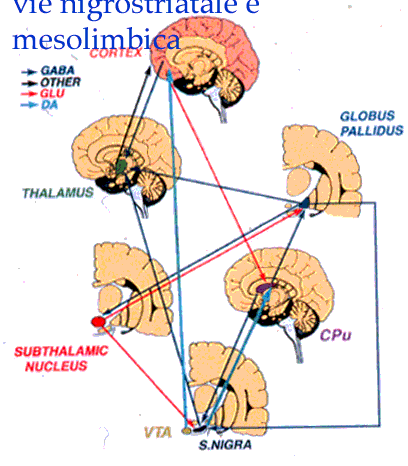GENERATION OF DOPAMINERGIC (DA) NEURONS IN VITRO: AN
OPTIMAL SOURCE OF FUNCTIONAL NEURONS FOR GRAFTS TO
RESTORE NIGROSTRIATAL PATHWAY IN EXPERIMENTAL MODELS
OF PARKINSON'S DISEASE (PD).
In mammals most DA neurons are located in the midbrain (MES),
where they form the nigrostriatal and mesocorticolimbic pathways.
They are involved in motor control, cognition and emotion, and are
implicated in psychiatric and neurological disorders, including
schizophrenia and PD.
DA progenitors are "committed" to generate DA neurons by the action
of Sonic hedgehog (SHH) and FGF8. Subsequently, the function of
selectively activated transcription factors (TF) is required for the final
DA differentiation.
Nurr1 is a key TF in MES DA neuron differentiation, function and
pathology: it can regulate genes involved in DA neurotransmission;
its expression in stem cells drives differentiation into DA neurons; its
ablation impairs midbrain DA neurons formation. Nurr1 expression is
maintained in mature MES DA neurons to control normal DA
neurotransmission. Nurr1 polymorphism in humans is associated
with PD and mutations have been found in cases of schizophrenia
and manic-depressive disorder.
Dr. di Porzio and coworkers have demonstrated that during brain
development Nurr1 gene is highly expressed in MES DA neurons in a
sharp temporal window coinciding with the peak of DA birth,
suggesting that high levels of Nurr1 are required for the proper DA
differentiation.
The research of di Porzio's group has shown that Nurr1 gene
expression is plastic and can be modulated by neuronal activity,
mimicked by depolarization, which increases Nurr1 in a calcium
independent fashion. Thus modulation of Nurr1 in MES can regulate
DA neuron functions.
Preliminary experiments suggest that other TFs can sequester Nurr1.
By antisense experiments di Porzio's group has been able to
increase Nurr1 activity, which in turn increases its target gene
expression and thus DA neurotransmission.
Given the potential of MES DA neurons for therapeutical use in
nigrostriatal pathway restoration in PD, their enrichment has been a
goal for many years. To this aim, di Porzio's group has used the
combined action of SHH and FGF2 to stimulate MES neuroblast
proliferation and to expand in vitro the number of committed MES DA
neurons. As a result, SHH enhances DA differentiation in MES
neuronal precursors expanded in the presence of FGF2.
This work demonstrate that SHH direct DA differentiation in
proliferating DA precursors in vitro and enrich in MES DA neurons,
which could be used for nigrostriatal grafts. The interactions between
embryonic and adult neurons in the nigrostriatal pathway are highly
selective and only MES DA neurons grafted in hosts with
experimental PD can restore nigrostriatal function, but not other CNS
DA neurons.
Thus MES DA neurons enrichment and enhancement of DA activity
provides a new tool in regenerative medicine for PD.
Vedi anche:
Immagini:

